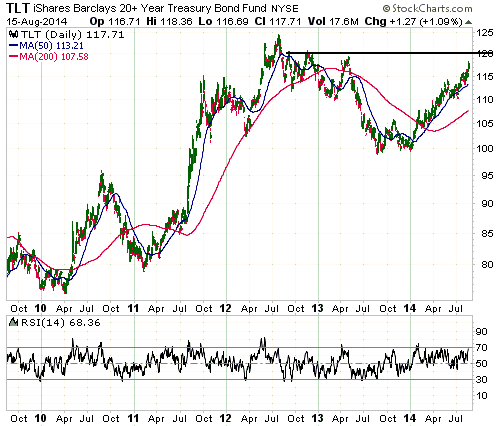One of the main reasons that T-Bonds continue to rise in price (fall in yield) is that most speculators continue to bet on a price decline (a rise in long-term interest rates). In other words, the sentiment backdrop remains supportive. It’s worth noting, for example, that despite the strong and consistent upward trend of the past 9 months, there is still a substantial speculative net-short position across the 30-year T-Bond and 10-year T-Note futures markets. Therefore, higher T-Bond/T-Note prices and lower long-term interest rates probably lie in store.
That being said, the iShares 20+ Year Treasury ETF (TLT) is now a) very ‘overbought’ by some measures (momentum, not sentiment), b) within 2% of intermediate-term resistance at 120, and c) within 6% of its mid-2012 all-time high. A test of resistance at 120 will almost surely happen and a test of the all-time high will possibly happen prior to the next intermediate-term peak, but a sustained break into all-time-high territory is very unlikely.

TSI was short-term bullish on US Treasury bonds from mid-December of last year through to mid-August of this year, but turned short-term “neutral” in a report published on 17th August. I expect to see additional gains in the T-Bond price and additional declines in the T-Bond yield over the next few months, but the short-term risk/reward is no longer skewed towards reward. It is also not skewed towards risk, meaning that it doesn’t yet make sense to bet against this market.
 Print This Post
Print This Post
